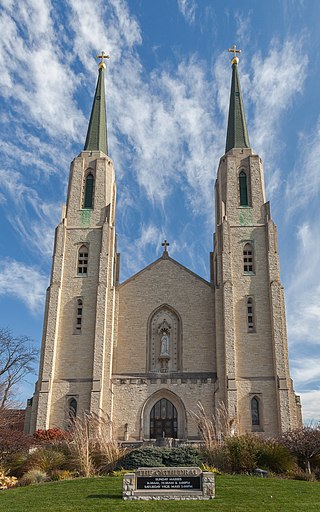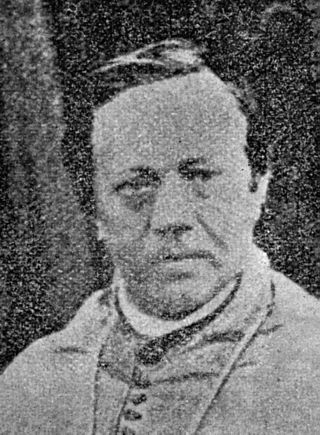
Fort Wayne is a city in and the county seat of Allen County, Indiana, United States. Located in northeastern Indiana, the city is 18 miles (29 km) west of the Ohio border and 50 miles (80 km) south of the Michigan border. The city's population was 263,886 as of the 2020 Census, making it the second-most populous city in Indiana after Indianapolis, and the 76th-most populous city in the United States. It is the principal city of the Fort Wayne metropolitan area, consisting of Allen and Whitley counties which had an estimated population of 423,038 as of 2021. Fort Wayne is the cultural and economic center of northeastern Indiana. In addition to the two core counties, the combined statistical area (CSA) includes Adams, DeKalb, Huntington, Noble, Steuben, and Wells counties, with an estimated population of 649,105 in 2021.

Defiance is a city in and the county seat of Defiance County, Ohio, United States, about 55 miles (89 km) southwest of Toledo and 47 miles (76 km) northeast of Fort Wayne, Indiana, in Ohio's northwestern corner. The population was 17,066 at the 2020 census.

John Chapman, better known as Johnny Appleseed, was an American pioneer nurseryman, who introduced apple trees to large parts of Pennsylvania, Ohio, Indiana, Illinois, and present-day Ontario, as well as the northern counties of present-day West Virginia. He became an American legend while still alive, due to his kind, generous ways, his leadership in conservation, and the symbolic importance he attributed to apples. He was also a missionary for The New Church (Swedenborgian) and the inspiration for many museums and historical sites such as the Johnny Appleseed Museum in Urbana, Ohio.

The Fort Wayne Children's Zoo is a zoo in Fort Wayne, Indiana, United States. Since opening in 1965, the 1,000-animal zoo has been located on 40 acres (16 ha) in Fort Wayne's Franke Park. The Fort Wayne Children’s Zoo is operated by the non-profit Fort Wayne Zoological Society under a cooperative agreement with the Fort Wayne Parks and Recreation Department. The zoo receives no tax funding for operations and operates solely on earned revenue and donations.

Fort Recovery was a United States Army fort ordered built by General "Mad" Anthony Wayne during what is now termed the Northwest Indian War. Constructed from late 1793 and completed in March 1794, the fort was built along the Wabash River, within two miles of what became the Ohio state border with Indiana. A detachment of Wayne's Legion of the United States held off an attack from combined Indian forces on June 30, 1794. The fort was used as a reference in drawing treaty lines for the 1795 Treaty of Greenville, and for later settlement. The fort was abandoned in 1796.

Allen County War Memorial Coliseum is a 13,000-seat multi-purpose arena located in Fort Wayne, Indiana, near present-day Johnny Appleseed Park. It opened in 1952 with a construction cost of nearly $3 million. The Allen County War Memorial Coliseum was originally designed to seat 8,103 for hockey or 10,240 for basketball. Opened in 1989, the Coliseum's $26 million Exposition Center contains 108,000-ft² (0.100-km2) devoted to hosting substantial trade shows and other events with seating for 7,500.

Fort Wayne was a series of three successive military log stockades existing between 1794 and 1819 on the confluence between the St. Mary's and St. Joseph Rivers in northeastern Indiana, in what is now the city of Fort Wayne. The fort succeeded the original Fort Miami near Kekionga, the principal village of the Miami; The origins of which date back to the early 1700s.
Fort Miami, originally called Fort St. Philippe or Fort des Miamis, were a pair of French built palisade forts established at Kekionga, the principal village of the Miami. These forts were situated where the St. Joseph River and St. Marys River merge to form the Maumee River in Northeastern Indiana, where present day Fort Wayne is located. The forts and their key location on this confluence allowed for a significant hold on New France by whomever was able to control the area, both militarily for its strategic location and economically as it served as a gateway and hotbed for lucrative trade markets such as fur. It therefore played a pivotal role in a number of conflicts including the French and Indian Wars, Pontiac's War, and the Northwest Indian War, while other battles occurred nearby including La Balme's Defeat and the Harmar campaign. The first construct was a small trading post built by Jean Baptiste Bissot, Sieur de Vincennes around 1706, while the first fortified fort was finished in 1722, and the second in 1750. It is the predecessor to the Fort Wayne.

The Cathedral of the Immaculate Conception in Fort Wayne, Indiana, is the primary cathedral of the Roman Catholic Diocese of Fort Wayne-South Bend, headed by Most Rev. Kevin Carl Rhoades. The parish was established in 1836, making it the oldest in Fort Wayne. The church was erected in 1860.

Chain O'Lakes is an Indiana state park on 2,718 acres (11.00 km2) in Noble County, Indiana, in the United States. The park is located near the towns of Albion and Avilla and is 19 miles (31 km) northwest of the northeastern Indiana's major city, Fort Wayne.

Nickel Plate Road 765 is a class "S-2" 2-8-4 "Berkshire" type steam locomotive built for the New York, Chicago & St. Louis Railroad, commonly referred to as the "Nickel Plate Road". In 1963, No. 765, renumbered as 767, was donated to the city of Fort Wayne, Indiana, where it sat on display at the Lawton Park, while the real No. 767 was scrapped in Chicago in 1964.

John Henry Luers was an American prelate of the Roman Catholic Church. He served as the first bishop of the new Diocese of Fort Wayne in Indiana from 1858 until his death in 1871.

Milan Township is one of twenty townships in Allen County, Indiana, United States. Milan Township is located in east central Allen County, with the Maumee River meandering across the township. As of the 2010 census, its population was 3,749. The township is highly rural, with only 1,137 houses in the 2010 census. Many of the residents of Milan Township are Swiss Amish who mostly speak a Low Alemannic Alsatian dialect. Milan township is generally demarcated by Schwartz Road to the west, Notestine Road to the north, Sampson Road to the east, and Gar Creek Road to the south.

Joseph Ketchum Edgerton was an American lawyer and politician who served one term as a U.S. Representative from Indiana from 1863 to 1865.

The following outline is provided as an overview of and topical guide to the U.S. state of Indiana:

This is a list of the National Register of Historic Places listings in Tippecanoe County, Indiana.

Smith Field is a public airport north of downtown Fort Wayne, in Allen County, Indiana. It is owned and operated by the Fort Wayne Allen County Airport Authority. In the FAA's National Plan of Integrated Airport Systems for 2009–2013 it is a general aviation airport. The airport was listed on the National Register of Historic Places in 2002.
The Three Rivers Festival is an annual multi-day event held in Fort Wayne, Indiana. The festival spans nine days in mid-July, starting on the first Friday after Independence Day. It is a celebration of the heritage of Fort Wayne, established during the French and Indian War at the confluence of three rivers - the Maumee, St. Marys, and St. Joseph. Events include concerts, a community parade, amusement rides, a bed race, art and craft shows, children's and seniors mini-fests, an International Village, and a fireworks finale.

The Fort Wayne Public Transportation Corporation (FWPTC), branded as Citilink, is the public transportation operator for the metro area of Fort Wayne and Allen County, Indiana. Transportation is provided Monday through Saturday on twelve fixed route lines plus two deviation routes. Citilink does not operate on Sundays and six holidays.

Trinity Episcopal Church is a historic Episcopal congregation and church, designed by Toledo, Ohio architect Charles Crosby Miller and constructed ca. 1865 in Fort Wayne, Indiana. The congregation was organized in 1839 as Christ Church and the name changed in 1844 to Trinity Church. The first church was built on the southeast corner of Berry and Harrison Streets in 1848. It is an example of Gothic Revival architecture.

















